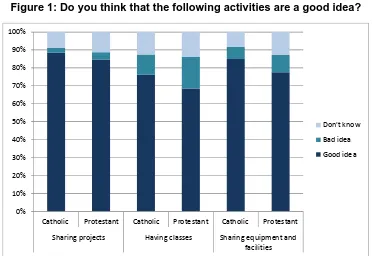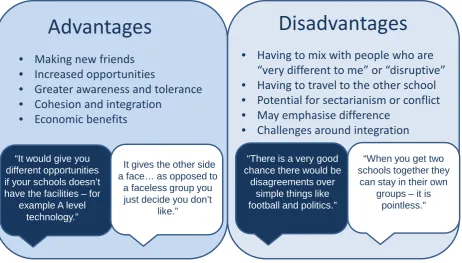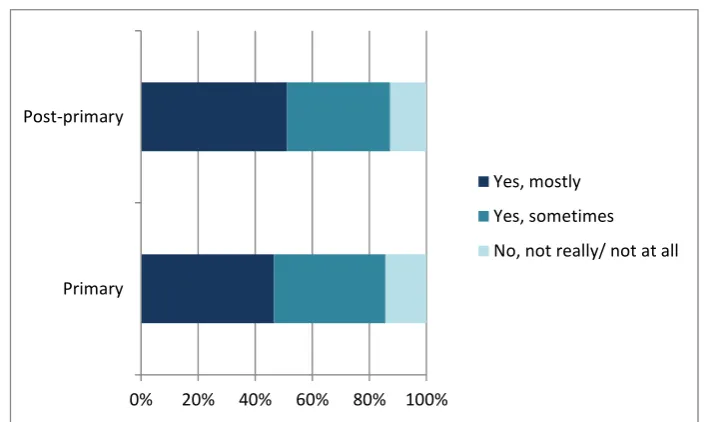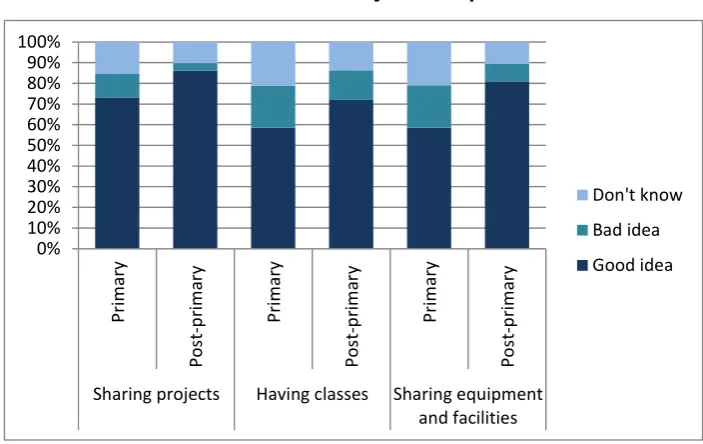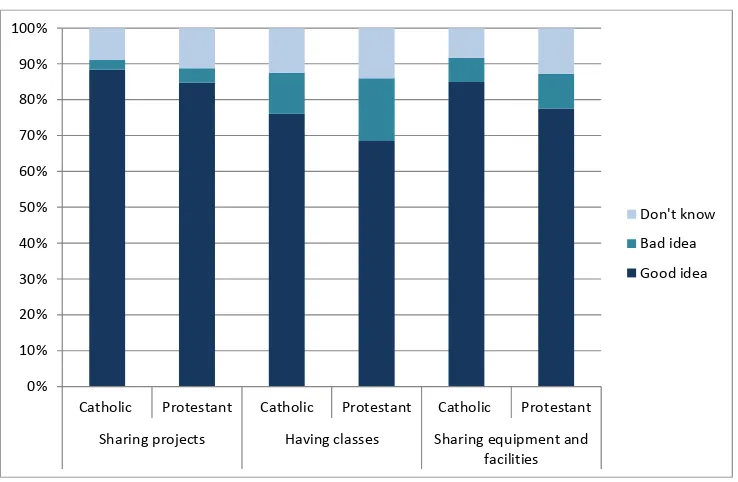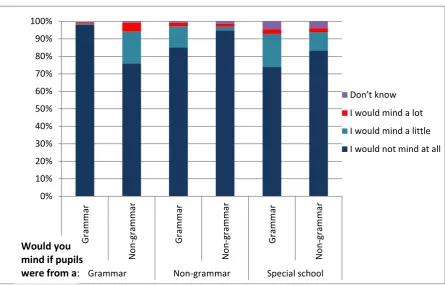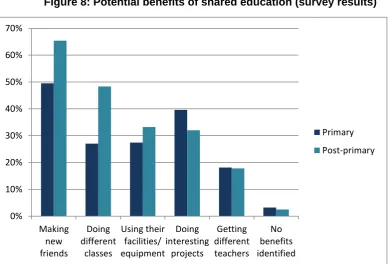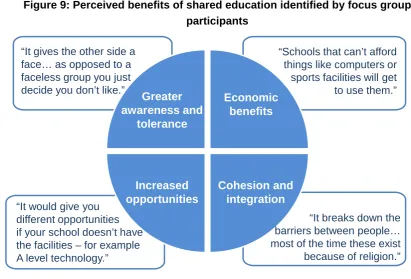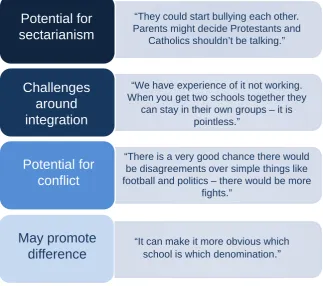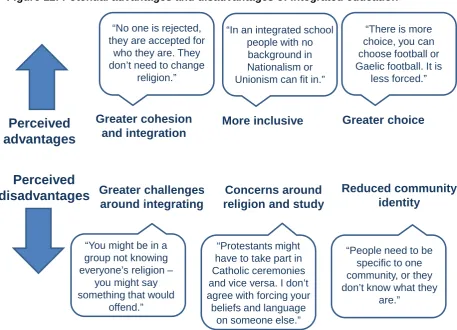Research
Thi
survey
PaperRes
and InformationYo
sha
is research
ys conduct
86/15search
n Service briefin
Ca
ung
aring
h paper pre
ted with ch
h and
Rese
ngs are compiled
29
tharoline Pe
peo
g and
edu
esents the
hildren and
and inte
Inform
earch P
d for the benefit h
January 2
erry and B
ople’
d int
ucat
NIAR 887-14
findings o
d young pe
egrated ed
mation
Paper
t of MLAs and th
2015
arbara Lo
’s vie
tegra
tion
4of a series o
eople, explo
ducation
n Serv
r
heir support sta
ove
ews
ation
of focus gr
oring their
vice
aff. Authors are
on
n in
roups and
views on s
Janua
available to
two
shared
Key
Points
• This paper considers the views of children and young people gathered through focus groups and through additional analysis of existing survey data;
• More primary pupils have participated in shared education (88% compared to 55% at post-primary);
• A majority of respondents to the survey thought that shared education was a ‘good idea’, with greater support evident at post-primary;
• Catholic students were more likely to state that shared education was a good idea and less likely to say that they had not enjoyed the projects they had participated in than their Protestant counterparts;
• Students tended to be less willing to share projects with schools of a different management type;
• A number of students questioned the value of shared education and suggested that it could emphasise differences;
• Potential advantages highlighted by young people included increased educational opportunities, making new friends and greater tolerance;
• Perceived disadvantages included having to mix with people perceived as being very different to them or disruptive, challenges around integrating during shared education and having to travel to another school;
• There was support for integrated education among most participants in the focus groups, although some stated that they preferred to attend school alongside others of a similar background;
• This paper has highlighted a number of areas that could be given further consideration, including:
o The reasons why more primary pupils have participated in shared education; o The different levels of support for and enjoyment of shared education
between Protestants and Catholics;
o The reluctance of some students to take part in shared education with schools of a different management type;
o The perception of some participants that shared education may accentuate differences between pupils;
NIAR 887-14 Research Paper
Executive
Summary
Introduction
The Committee for Education is carrying out an inquiry into shared and integrated education. This research paper explores the views of children and young people gathered through a series of focus groups and an analysis of the 2012 Kids’ Life and Times and Young Life and Times survey data.
Experience of shared education
Data from the surveys shows that more primary school pupils have participated in shared education - 88% of primary survey respondents had shared projects with pupils from other schools, compared to 55% at post-primary. Most of those who had
participated stated that they enjoyed it ‘sometimes’ or ‘mostly’. Views on shared education
[image:5.595.126.498.449.705.2]A majority of survey respondents thought that sharing classes with children from other schools was a ‘good idea’, with greater support at post-primary (72% compared to 59% at primary). There was more support for sharing projects than classes with other pupils. With regard to religious background, Catholics were more likely to believe that sharing in education was a good idea, and less likely to note that they did not enjoy the shared education projects they had participated in (4% compared to 13% of Protestants).
Figure 1: Do you think that the following activities are a good idea?
The evidence also suggests that students tend to be less willing to share projects with schools of a different management type. For example, while 98% of grammar
respondents would be happy to share projects with another grammar, a lower 0%
10% 20% 30% 40% 50% 60% 70% 80% 90% 100%
Catholic Protestant Catholic Protestant Catholic Protestant
Sharing projects Having classes Sharing equipment and
facilities
Don't know
Bad idea
NIAR 887-14 Research Paper
Northern Ireland Assembly, Research and Information Service 4 proportion stated that they would not mind sharing with a non-grammar (85%) or special school (74%). Students from integrated schools were the most willing to share with schools of a different management type.
A majority of participants in the focus groups were in favour of shared education, although some were reluctant to share with schools of a different religious denomination. A number of students questioned the value of shared education, suggesting that it could actually emphasise differences between people of different backgrounds.
Advantages and disadvantages of shared education
[image:6.595.76.539.409.672.2]Participants in the focus groups and survey respondents highlighted a range of potential benefits and disadvantages that could arise from sharing with other schools; these are illustrated in Figure 2.
Figure 2: Perceived advantages and disadvantages of shared education
With regard to the perceived benefits, post-primary survey respondents were more likely to highlight making new friends and doing different classes as a benefit; while a higher proportion of primary pupils thought that doing interesting projects would be an advantage.
Advantages
Disadvantages
•
Making
new
friends
•
Increased
opportunities
•
Greater
awareness
and
tolerance
•
Cohesion
and
integration
•
Economic
benefits
“It would give you different opportunities if your schools doesn’t have the facilities – for
example A level technology.”
“It gives the other side
a face… as opposed to a faceless group you just decide you don’t
like.”
•
Having
to
mix
with
people
who
are
“very
different
to
me”
or
“disruptive”
•
Having
to
travel
to
the
other
school
•
Potential
for
sectarianism
or
conflict
•
May
emphasise
difference
•
Challenges
around
integration
“When you get two schools together they
can stay in their own groups – it is
pointless.” “There is a very good
chance there would be disagreements over
simple things like football and politics.”
In terms of disadvantages, Protestant respondents were more likely to be concerned about mixing with children of a different religion (8% compared to 4% of Catholic respondents).
There were also differences by school management type, with just under a quarter (23%) of non-grammar respondents stating that mixing with people very different to themselves would be a disadvantage, compared to 16% of grammar students and 10% of respondents from integrated schools.
Integrated education
A majority of participants in the focus groups supported integrated education. However, some students stated that they would prefer to attend a school alongside others from a similar background, and highlighted the importance of school choice. Students from Irish-medium and integrated education were also supportive of the integrated model. The perceived advantages include:
• Greater cohesion and integration;
• More inclusive for pupils from a range of backgrounds; • Greater choice.
However, some pupils identified a number of potential disadvantages, including reduced community identity, challenges around integrating and concerns about which subjects or sports they would be required to study or play.
Conclusion
This paper has highlighted a number of areas that could be given further consideration, including:
• The reasons why more primary pupils have participated in shared education; • The different levels of support for and enjoyment of shared education between
Protestants and Catholics;
• The reluctance of some students to take part in shared education with schools of a different management type;
• The perception of some participants that shared education may accentuate differences between pupils;
• The extent to which pupils from different schools integrate when they take part in shared education.
“No one is rejected; they are accepted for who they are.”
Contents
Key Points ... 1
Executive Summary ... 3
Contents 1 Introduction ... 9
2 Methodology ... 9
3 Experience of shared education ... 9
4 Views on shared education ... 11
5 Advantages of shared education ... 14
6 Disadvantages of shared education ... 15
7 Views on integrated education ... 17
1 Introduction
The Committee for Education is currently undertaking an inquiry into shared and integrated education. In order to consider the views of children and young people, this research paper highlights the findings of a series of focus groups conducted with children and young people. It includes a data analysis conducted by the Northern Ireland Assembly Research and Information Service (RaISe) of the 2012 Kids’ Life and Times Survey1 and Young Life and Times Survey2.
2 Methodology
A series of ten focus groups was held with primary, post-primary and special schools, comprising controlled, Catholic maintained, integrated, Irish-medium and voluntary grammar schools. The Assembly’s Education Officers facilitated the groups.
The Kids’ Life and Times Survey is an annual online survey of Primary 7 (P7) children carried out in school. In 2012, a total of 4,200 P7 children participated in the survey, mostly aged between 10 and 11 years old. The Young Life and Times Survey is an annual postal survey of 16 year olds; 1,210 young people participated in 2012. These surveys included modules on shared education.
The datasets were downloaded from the ARK (Access Research Knowledge) website, a resource aimed at making social and political information on Northern Ireland
available to a wide audience, and analysed by RaISe using SPSS. This allowed for further analysis of the Young Life and Times Survey by school type and pupils’ religious background. Questions on school management type or religion were not asked in the Kids’ Life and Times Survey.3
3
Experience of shared education
Data from the Kids’ Life and Times and the Young Life and Times Survey shows that more pupils from primary schools have participated in shared education than their counterparts at post-primary.
Under three quarters (71%) of post-primary and 61% of primary respondents reported that some of the pupils they participated in shared education had a different religious background.
1
ARK Kids’ Life and Times [online] Available at: http://www.ark.ac.uk/klt/ 2
ARK Young Life and Times Survey [online] Available at: http://www.ark.ac.uk/ylt/ 3
NIAR 887-14 Research Paper
[image:12.595.134.490.107.320.2]Northern Ireland Assembly, Research and Information Service 10 Figure 3: Have you ever participated in the following activities with children from
other schools? By school phase
Pupils from non-grammar post-primaries were least likely to have participated in shared education (20% stated that they had not), followed by pupils from grammar schools (18%). Students from integrated schools were most likely to have participated in shared education, with 11% stating that they had not previously done so.
The surveys indicate that most children and young people who participated in shared education enjoyed the experience either ‘sometimes’ or ‘mostly’. For example, 88% of primary respondents and 91% of post-primary respondents enjoyed doing projects with other children.
Figure 4: Did you enjoy having classes with the other children? By school phase
However, there were marked differences by religious background, with 13% of Protestant respondents stating that they did not enjoy the shared education projects they participated in, compared to 4% of their Catholic counterparts.
0% 10% 20% 30% 40% 50% 60% 70% 80% 90% 100%
Shared classes Done projects Shared equipment or sports facilities
Primary Post‐primary
0% 20% 40% 60% 80% 100% Primary
Post‐primary
[image:12.595.138.491.496.707.2]4
Views on shared education
The survey evidence suggests that a majority of young people believe that sharing classes with children from other schools was a ‘good idea’. There was generally more support at post-primary, with 72% of respondents believing that sharing classes is a good idea compared to 59% of primary pupils. There was also greater support for sharing projects compared to having classes or sharing equipment.
[image:13.595.105.457.290.512.2]In the survey pupils from integrated schools were more likely to feel that sharing projects, classes and equipment with other schools was a good idea - 88% stated that sharing classes was a good idea, compared to 70% of grammar and 73% of non-grammar respondents.
Figure 5: Do you think that the following shared education activities are a good idea? By school phase
In the focus groups the majority of primary school pupils supported shared education and stated that they would be willing to take part in classes with pupils from schools of a different religion. Pupils from an integrated primary highlighted a preference for fully integrated education rather than shared education.
At post-primary many students were very supportive of the concept, highlighting benefits such as increased access to resources and integrating with people from a different background. 0% 10% 20% 30% 40% 50% 60% 70% 80% 90% 100% Pr imar y Pos t ‐ pr im ar y Pr imar y Pos t ‐ pr im ar y Pr imar y Pos t ‐ pr im ar y
Sharing projects Having classes Sharing equipment and facilities
Don't know Bad idea Good idea
NIAR 887-14 Research Paper
Northern Ireland Assembly, Research and Information Service 12 However, some post-primary students were reluctant to share classes or resources with students from other schools. They highlighted concerns around logistical and financial issues, as well as concerns around mixing with pupils from other schools, the potential for sectarianism and having to share resources with others.
Some focus group participants agreed in principle to the idea of shared education, but voiced fears around having to study particular subjects, for example Irish, or play particular sports.
[image:14.595.107.476.515.756.2]With regard to religious background, Catholic survey respondents were more likely to state that shared education with pupils of a different religion was a good idea. When asked whether they would mind doing a project with children of a different religious background, 83% of Catholic students stated that they “would not mind at all”, compared to 79% of Protestant respondents.
Figure 6: Do you think that the following shared education activities are a good idea? By religious background
0% 10% 20% 30% 40% 50% 60% 70% 80% 90% 100%
Catholic Protestant Catholic Protestant Catholic Protestant
Sharing projects Having classes Sharing equipment and
facilities
Don't know
Bad idea
Good idea
“It gives you the opportunity to make more friends. You would meet more people and meet people of different religious beliefs; it would give you a flavour of different religions.” (Post-primary participant)
“It could be complicated, like if someone walked in in a Rangers top and one in a Celtic top and that starts something.” (Post-primary participant)
Our analysis of the survey data also found that students tend to be more willing to share projects with other schools of a similar management type. For example, 98% of grammar school respondents stated that they “would not mind at all” sharing projects with pupils of another grammar school, while 85% would not mind sharing with a non-grammar and 74% would not mind sharing with pupils from a special school.
Similarly, 95% of grammar students would not mind sharing with another non-grammar, while 76% would not mind sharing with a grammar and 83% would not mind sharing with a special school.
[image:15.595.100.546.325.611.2]Students from integrated schools were the most willing to share with schools of a different management type, with 95% stating that they would not mind sharing with a non-grammar, 79% noting that they would not mind sharing with a grammar, and 85% saying that they would not mind sharing with a special school.
Figure 7: Would you mind if young people from the following types of schools came to do a project with your class? By school management type
In the focus groups some pupils questioned the extent to which shared education promotes integration in practice, suggesting that it may instead highlight differences between people of different community backgrounds.
0% 10% 20% 30% 40% 50% 60% 70% 80% 90% 100% Gr am ma r Non ‐ gram mar Gr am ma r Non ‐ gram mar Gr am ma r Non ‐ gram mar
Grammar Non‐grammar Special school
Don't know I would mind a lot I would mind a little I would not mind at all
Would you
NIAR 887-14 Research Paper
Northern Ireland Assembly, Research and Information Service 14
5
Advantages of shared education
[image:16.595.101.494.316.580.2]Answering a multiple-choice question in the survey, students identified a number of potential benefits of shared education. These are illustrated in Figure 8.
Figure 8: Potential benefits of shared education (survey results)
The survey highlighted few differences in opinion by religious background for this question, although Catholic survey respondents were more likely to note having the opportunity to be taught by different teachers as a potential advantage (20% compared to 16% of Protestants).
Participants in the focus groups highlighted a number of potential benefits they felt could arise from sharing classes, projects or sports with pupils of a different religious background; these are illustrated in Figure 9 overleaf.
Many of these centre on mixing with people from a different background, and as a result promoting tolerance across communities. Some students also alluded to the
0% 10% 20% 30% 40% 50% 60% 70%
Making new friends
Doing different
classes
Using their facilities/ equipment
Doing interesting
projects
Getting different teachers
No benefits identified
Primary Post‐primary
“Shared education is getting Protestants and Catholics, putting them on the same campus and that is it. It is almost promoting their differences, which in turn causes sectarian behaviour – we all know how that turns out.” (Post-primary participant)
potential economic benefits and the greater opportunities that could be afforded by schools sharing resources and facilities.
Figure 9: Perceived benefits of shared education identified by focus group participants
6
Disadvantages of shared education
Again answering a multiple-choice question in the survey, respondents highlighted a number disadvantages they thought could arise from shared education (Figure 10 overleaf). The most common concern of both primary and post-primary respondents to the survey was having to mix with children they thought were ‘rough, disruptive or annoying’.
Mixing with children of a different religion was cited as a potential disadvantage by a minority of respondents: 12% of primary pupils and 5% of post-primary pupils. This was of a greater concern for Protestant students (8% compared to 4% of Catholic
respondents). A fifth of post-primary students did not select any of the disadvantages in the questionnaire.
There were also differences by school management type, with 23% of non-grammar respondents highlighting having to mix with people very different to themselves as a concern, compared to 16% of grammar students and 10% of respondents from integrated schools.
Greater awareness and
tolerance
Economic benefits
Increased opportunities
Cohesion and integration
“It would give you different opportunities if your school doesn’t have the facilities – for example A level technology.”
“It gives the other side a face… as opposed to a faceless group you just decide you don’t like.”
“It breaks down the barriers between people… most of the time these exist because of religion.” “Schools that can’t afford things like computers or
NIAR 887-14 Research Paper
[image:18.595.99.539.75.372.2]Northern Ireland Assembly, Research and Information Service 16 Figure 10: Potential disadvantages of shared education
Participants in the focus groups also highlighted a number of disadvantages they thought could arise from sharing classes or taking part in activities with students from schools of a different religion, outlined in Figure 11.
Figure 11: Perceived disadvantages of shared education identified by focus group participants 0% 10% 20% 30% 40% 50% 60% 70% 80%
Having to be
with children I
think are rough,
disruptive or
annoying
Having to mix
with children
who are very
different from
me
Having to travel
to get to the
other school
Having to be
with children of
a different
religion
Having to share
our sports
facilities or
computers
I don't mind any
of these
Primary
Post‐primary
Potential for
sectarianism
Challenges
around
integration
May promote
difference
Potential for
conflict
“We have experience of it not working. When you get two schools together they
can stay in their own groups – it is pointless.”
“It can make it more obvious which
school is which denomination.”
“There is a very good chance there would be disagreements over simple things like football and politics – there would be more
fights.”
“They could start bullying each other. Parents might decide Protestants and
[image:18.595.145.469.484.770.2]7
Views on integrated education
At primary, a majority of focus group participants supported the idea of integrated education. At post-primary pupils generally advocated integrated education over shared education, pointing to benefits around inclusion and integration. However, a minority of pupils stated that they would not like to attend an integrated school, preferring instead to attend school alongside pupils from a similar background. Students who attended integrated schools were particularly supportive of the model, with most preferring it to shared education. Some, however, supported school choice and advocated having both shared and integrated approaches available. Participants in Irish-medium education were also supportive of integrated education.
[image:19.595.109.567.436.766.2]The following figure highlights the main potential advantages and disadvantages of integrated education highlighted by participants in the focus groups.
Figure 12: Potential advantages and disadvantages of integrated education
Greater cohesion and integration
More inclusive Greater choice
Reduced community identity
Concerns around religion and study Greater challenges
around integrating
“There is more choice, you can choose football or Gaelic football. It is
less forced.” “No one is rejected,
they are accepted for who they are. They don’t need to change
religion.”
“People need to be specific to one community, or they don’t know what they
are.” “Protestants might
have to take part in Catholic ceremonies and vice versa. I don’t agree with forcing your
beliefs and language on someone else.” “You might be in a
group not knowing everyone’s religion –
you might say something that would
offend.”
“In an integrated school people with no background in Nationalism or Unionism can fit in.”
Perceived
advantages
Perceived
disadvantages
“I like both ideas, but my favourite would be integrated education… I think it brings people together.” (Primary participant)
NIAR 887-14 Research Paper
Northern Ireland Assembly, Research and Information Service 18
8 Conclusion
This paper has shown that a majority of pupils are in favour of shared education, with most also supportive of integrated education. However, some participants in the
research highlighted a number of concerns and potential disadvantages around sharing projects, classes or facilities with students from other schools. Areas that could be given further consideration include:
• The reasons why more primary school pupils have participated in shared education than their counterparts at post-primary;
• The different levels of support for and enjoyment of shared education between Protestants and Catholics;
• The reluctance of some students to take part in shared education with schools of a different management type;
• The perception of some focus group participants that shared education may accentuate differences between pupils;
